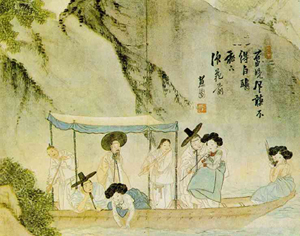
Class Distinctions
Music's transition from workplace to stage is a metaphor of human evolution from tribe to complex, industrial society. The seventeenth and eighteenth centuries were a time of major economic, social, political, and cultural transition in Korea. Undergoing two major foreign invasions-by the Japanese (1592-1597) and by the Manchu (1627-1636)-that devastated the nation, Koreans became substantially disillusioned by the Neo-Confucian world order that granted privileges and opportunities exclusively to members of yangban, the ruling class, who had failed to protect them from the invasions.
Economically, however, the advancement of agricultural technology was leading to increased production, and "a market economy was arising and with it accumulation of wealth and the formation of a bourgeois potential clientele for arts and aesthetics."[8]"Chan E. Park, Voices from the Straw Mat, 27." The blurring of social boundaries coupled with the formation of a bourgeois class meant increased visibility and support for artists and musicians. Let us look at another painting by Shin Yunbok, "Boat riding down the blue river" (Chuyu ch´ônggang).
The painting depicts an unrestrained mixing and mingling across class, gender, and genre. The kisaeng, kwangdae, yangban, scholars, and boatman all are in the same poetic zone flowing down the river. Listen to the Boat Rowing Song, a folk song gentrified by a stage voice (Kim Sohûi and the chorus):
Composer: 0
-
"Kim Sohui - Boat Rowing Song"
|
Lyrics
|
|
Endless blue ocean, waves upon waves…
Favorable wind, so set sail, ôgiyôch´a! Heave! Seagulls circle high above, in, out, of the clouds. Ogiyadiyoch´a! Heave! |
| Translation by Kim Sohûi. |
With a breakdown of social taboos comes a breakdown of artistic taboos, and vice versa. Inspiration was flying from field to stage, from folk to pop, as professional singers and musicians found musical motifs from folk songs ripe for popular stage adaptation. In the process, instruments, rhythms, and melodies were borrowed and shared across class, genre, region, and gender. Korean music thus entered the twentieth century, this time to compete, clash, and fuse with Western musical influences in the backdrop of difficult sociopolitical, cross-cultural, and trans-national challenges that continue into the twenty-first century. Korean traditional music continues to be performed with the spirited exuberance of the past but in a different setting, on stage, for different audiences of today.





Trot (Teuroteu) is the oldest type of Korean pop music originating during Japanese rule in the first half of the 20th century.





